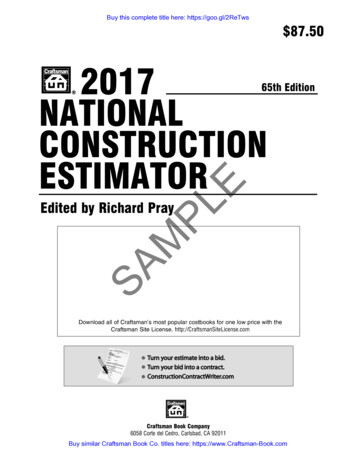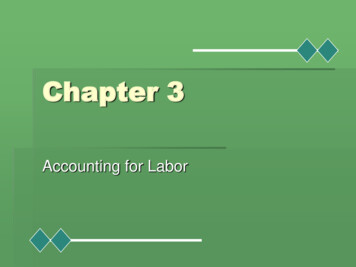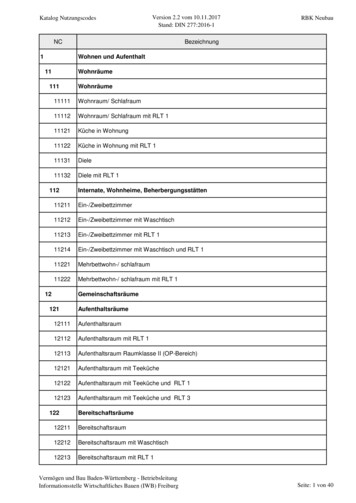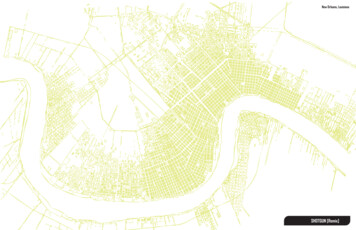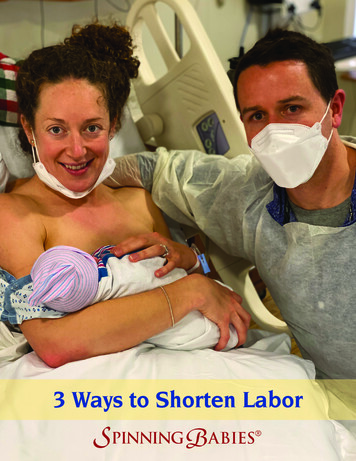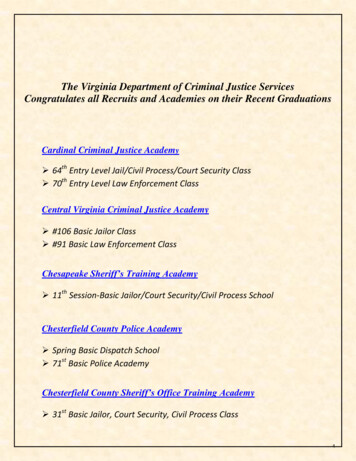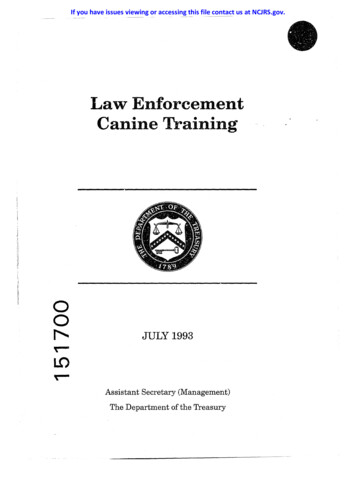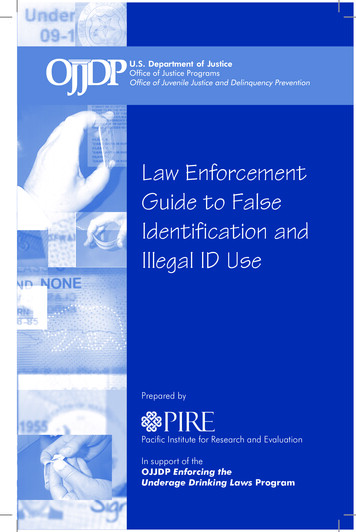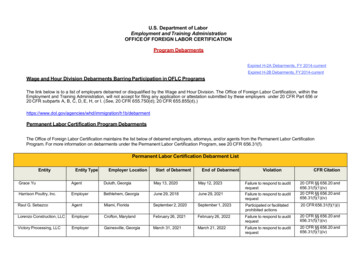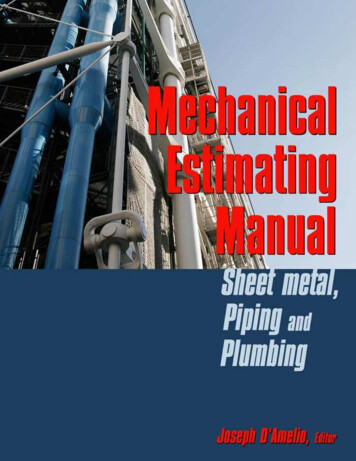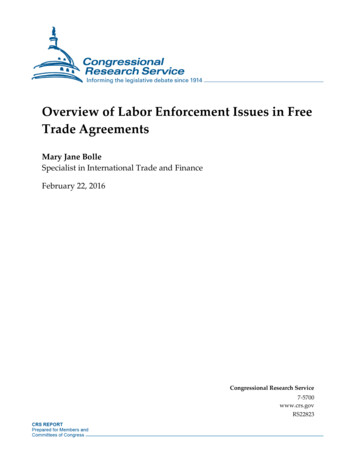
Transcription
Overview of Labor Enforcement Issues in FreeTrade AgreementsMary Jane BolleSpecialist in International Trade and FinanceFebruary 22, 2016Congressional Research Service7-5700www.crs.govRS22823
Overview of Labor Enforcement Issues in Free Trade AgreementsSummarySince 1993, the Administration has negotiated and Congress has approved 13 free tradeagreements (FTAs) with labor provisions, and is considering additional FTAs. Based on similarityof language, these FTAs can be sorted into four groups, or “models,” which have evolved tocontain successively greater levels of enforceability. This report first identifies the enforceablelabor provisions in each model. Second, it identifies two types of labor enforcement issues: (1)those that relate to the FTA provisions themselves, including their definitions and theirenforceability, and (2) those that relate to executive branch responsibilities, such as resourceavailability and determining dispute settlement case priorities. This report does not address otherlabor issues in the various free trade agreements, including cooperative consultation and capacitybuilding provisions.Congressional Research Service
Overview of Labor Enforcement Issues in Free Trade AgreementsContentsBackground . 1Labor Enforcement in U.S. Free Trade Agreements . 2Model 1: NAFTA . 2Model 2: Jordan. 3Model 3: Seven FTAs. 3Model 4: May 10th Agreement . 3Four FTAs . 3Proposed TPP . 4Enforcement Issues. 51. Only Some Labor Provisions Are Enforceable . 52. Different Enforcement Procedures for and Caps on Penalties for Labor Provisions . 53. Limits Placed on Scope of Definition of a Term in Labor Provisions . 54. Differentials in Procedures for Considering Disputes on Labor vs. Other Provisions . 65. Priorities for Disputes to be Pursued by the USTR . 6ContactsAuthor Contact Information . 7Congressional Research Service
Overview of Labor Enforcement Issues in Free Trade AgreementsBackgroundThe inclusion of enforceable labor provisions—that is, those subject to dispute resolutionprocedures—in various trade agreement authorities and related reciprocal trade agreements hasevolved over time.1 At first, U.S. trade policy focused on lowering tariffs on goods. It was laterextended to various types of nontariff barriers.Labor principles and standards are not subject to World Trade Organization (WTO) rules anddisciplines. The International Labor Organization (ILO), an arm of the United Nations founded in1919, is the multilateral organization with responsibility for labor issues. For nearly 90 years, theILO has been working to create, through adoption at its annual International Labor Conferencesof Member countries, Conventions, which set international standards.The ILO has adopted at least 183 Conventions, eight of which define four “core labor” principles.This occurred when first, a U.N. Social Summit in Copenhagen, Denmark, in 1995 declared thatfour categories of principles and rights at work are fundamental: (1) freedom of association andcollective bargaining; (2) the elimination of forced labor; (3) the elimination of child labor; and(4) the elimination of discrimination in respect of employment and occupation.2 The ILO thenresponded by pulling these together as the 1998 ILO Declaration on Fundamental Principles andRights at Work and its Follow-Up. The Declaration commits all ILO Member States, whether ornot they have ratified the specific conventions, to respect the labor principles in these four keyareas. The Follow-Up, among other things, calls for reports by developing countries that have notratified one or more of the core Conventions, on the status of their implementation of the variousrights.3The United States had unilaterally promoted the development of “internationally recognizedworker rights,” principles similar to those in the ILO Declaration, through its trade preferencelaws for developing countries. These trade preference laws cover five main programs: theGeneralized System of Preferences (GSP), 1975; the Caribbean Basin Initiative (CBI), 1983; theAndean Trade Preference Act (ATPA), 1991; the African Growth and Opportunity Act (AGOA),2000; and the Haiti Opportunity through Partnership Act (HOPE), 2006. These laws all requirethat as a condition of obtaining and maintaining program eligibility, beneficiary countries musttake steps to afford their workers “internationally recognized worker rights.” These rights arelisted in Trade Act of 1974, as amended (Section 507), as similar to ILO core labor principleslisted above, except the U.S. list substitutes for the fourth principle listed above: “acceptableconditions of work with respect to minimum wages, hours of work, and occupational safety andhealth.”4In 1996, backed by the United States and other developed countries, the then-124-member WTOdebated whether to form a committee to look into the relationship between trade and laborstandards. Developing countries, in the majority, argued that the issue had no place in the WTOframework; was little more than a smokescreen for protectionism; and was a bid by industrial1Trade promotion authority refers to presidential authority to enter into trade agreements that Congress considers underexpedited procedures (most recently in Title XXI of the Trade Act of 2002, P.L. 107-210). For more information, seeCRS Report RL33743, Trade Promotion Authority (TPA) and the Role of Congress in Trade Policy.2United Nations World Summit for Social Development, Copenhagen. March 6-12. 1995.3ILO Declaration on Fundamental Principles and Rights at Work and its Follow-Up: About the Declaration. From theILO website, at http://www.ilo.org.4See Trade Act of 1974 (P.L. 93-618 as amended), Sec. 507 (4)(E).Congressional Research Service1
Overview of Labor Enforcement Issues in Free Trade Agreementsnations to undermine the comparative advantage of lower-wage trading partners.5 Ultimately theyprevailed. The Singapore Ministerial Declaration, reporting on what they decided, stated that theILO (rather than the WTO) would be the “competent body to set and deal with . internationallyrecognized core labor standards.”6 The ILO has no enforcement tools, but rather promotes laborstandards through consensus, moral suasion, and technical assistance.Inclusion of labor provisions in bilateral U.S. trade agreements has evolved. The first two U.S.FTAs with Israel, 1985, and Canada, 1988, did not include labor provisions. This pattern began tochange after 1993, when a number of factors came into play. First, the United States began toundertake FTA negotiations with lesser-developed countries. Second, it became increasinglyaccepted that labor issues were related to trade and trade policy. Third, consensus broadened thatglobalization had both costs and benefits. The benefits tend to be broadly dispersed and includerelatively higher economic growth and productivity and greater access to lower-priced goods. Thecosts tend to be concentrated in import-competing sectors where there may be downward pressureon wages and job displacement. In developing countries, pressures to become a low-cost producercan lead to diminished working conditions and diminished worker rights. Fourth, business groupshave increasingly been willing to make some concessions to labor groups in order to promotetrade agreements and pave the way for greater trade with and investment in developing countries.Labor Enforcement in U.S. Free Trade AgreementsSince 1993, the United States has negotiated 13 FTAs that include 19 countries.7 8 These are,chronologically, the North American Free Trade Agreement (NAFTA) with Mexico and Canada;bilateral agreements with Jordan, Chile, Singapore, Australia, Morocco, Bahrain, and Oman; aregional agreement known as CAFTA-DR, with the Dominican Republic and the five CentralAmerican Countries (Costa Rica, El Salvador, Guatemala, Honduras, and Nicaragua); andbilateral FTAs with Peru, Colombia, Panama, and South Korea. The last four agreements reflect abipartisan compromise on labor language as delineated in the “Bipartisan Trade Deal” (popularlyknown as the “May 10th Agreement,”) jointly agreed to between the leadership in Congress andthe Administration on May 10, 2007. This agreement calls for, among other things, severaladditional labor provisions in FTAs including: (1) a fully enforceable commitment that FTAcountries will adopt, maintain, and enforce in their laws and practice, the basic international laborstandards as stated in the 1998 ILO Declaration; and (2) the use of identical enforcementprovisions for labor and the other provisions in the agreements. Labor and enforcementprovisions in these various trade agreements can be categorized into four different models.Model 1: NAFTAFor NAFTA, labor provisions are included in the North American Agreement on LaborCooperation (NAALC), a side agreement, rather than in the main agreement. Under NAALC,countries agree to enforce their own labor laws and standards. However, under NAALC, the only5World Trade Organization, Singapore Ministerial Declaration, adopted December 13, 1996, Sec. 4, Core LabourStandards.6See WTO press brief on Trade and Labour Standards,http://www.wto.org/english/thewto e/minist e/min96 e/labstand.htm.7The U.S.-Israel Free Trade Agreement, which went into effect in 1985, did not contain any labor provisions.8For information on trade promotion authority under which these FTAs were negotiated and approved by Congress,see CRS Report RL33743, Trade Promotion Authority (TPA) and the Role of Congress in Trade Policy, by Ian F.Fergusson.Congressional Research Service2
Overview of Labor Enforcement Issues in Free Trade Agreementsprovision enforceable with sanctions is a Party’s “persistent pattern of failure . to effectivelyenforce its occupational safety and health, child labor or minimum wage technical standards,”where that failure is trade-related and covered by mutually recognized labor laws (Article 29). Bycomparison, all provisions relating to commercial operations are enforceable under the NAFTA.Furthermore, the labor side agreement has different enforcement procedures than does the mainagreement, and places limits on monetary enforcement assessments, with suspension of benefitsfor noncompliance.Model 2: JordanIn the U.S.-Jordan Free Trade Agreement, labor provisions and commercial provisions share thesame dispute resolution procedures. Among labor provisions, each Party agrees to “not fail toeffectively enforce its labor laws . in a manner affecting trade” (Article 6.4). Under the Jordanagreement, labor laws are defined as U.S. internationally recognized worker rights. All laborprovisions and commercial provisions are equally enforceable. If the dispute is not resolved underprocedures specified, the affected Party shall be entitled to take “any appropriate andcommensurate measure” (Article 17.2(b)). However, in an exchange of letters between the USTRRobert Zoellick and Jordanian Ambassador Marwan Muasher before Congress considered theimplementing legislation in 2001, the governments reportedly agreed to resolve any potentialdisputes without resorting to trade sanctions.9Model 3: Seven FTAsSeven trade agreements with 12 different countries (Chile, Singapore, Australia, Morocco,Bahrain, Oman, and the six CAFTA-DR countries) include only one enforceable labor provision:each country “shall not fail to effectively enforce its labor laws . in a manner affecting tradebetween the Parties.” The agreements define labor laws as “a Party’s statutes or regulations .that are directly related to” the list of U.S. internationally recognized worker rights. Allprovisions in these agreements relating to commercial operations are enforceable. The seven tradeagreements share many of the same procedures for labor and commercial disputes. Procedures forlabor disputes place limits on monetary penalties, whereas those for commercial disputes do not.Suspension of benefits is a “last recourse” option for both types of disputes.Model 4: May 10th AgreementFour FTAsOn May 10, 2007, the bipartisan leadership in Congress and the Administration agreed to aBipartisan Trade Deal to include, among other things, provisions in pending FTAs: with Peru,Colombia, Panama, and South Korea. These are (1) a fully enforceable commitment that Partiesto free trade agreements would adopt and maintain in their laws and practices the ILODeclaration; (2) a fully enforceable commitment prohibiting FTA countries from lowering theirlabor standards; (3) new limitations on “prosecutorial” and “enforcement” discretion (i.e.,countries cannot defend failure to enforce laws related to the five basic core labor standards onthe basis of resource limitations or decisions to prioritize other enforcement issues); and (4) the9Governments: “would not expect or intend to apply the Agreement’s dispute settlement enforcement procedures ina manner that results in blocking trade.” Jordan Free Trade Agreement Approved by Finance and Ways and Means,Inside U.S. Trade, July 27, 2001.Congressional Research Service3
Overview of Labor Enforcement Issues in Free Trade Agreementssame dispute settlement mechanisms or penalties available for other FTA obligations (such ascommercial interests).10The four concepts were incorporated into all four agreements in virtually identical form. Thelanguage appears to limit item (1) in the May 10th Agreement, described above, by including twofootnotes to the key provision: that each Party shall adopt and maintain in its statutes, regulations,and practices, the rights as stated in the ILO Declaration and its Follow-Up. The first footnotelimits obligations of Parties to those specified in the ILO Declaration (i.e., without also includingthe Follow-Up). The second footnote requires that a party seeking to challenge violations mustdemonstrate that the failure to adopt or maintain ILO core labor principles has been “in a manneraffecting either trade or investment between the two countries.”11 In Model 4 resolution ofdisputes may involve monetary assessments (with no dollar limits) and, if they are not paid,suspension of benefits until the non-conformity is eliminated. The most recent agreements wereapproved by Congress in the following implementing bills: with Peru, in 2007 (P.L. 110-138);with South Korea in 2011 (P.L. 112-41); with Panama in 2011 (P.L. 112-43); and with Colombiain 2012 (P.L. 112-42).Proposed TPPThe Trans-Pacific Partnership Agreement (TPP), whose text was released by President Obama onNovember 5, 2015, includes 11 countries bordering on the Pacific Ocean. Six are already coveredby previous FTAs: Australia, Canada, Chile, Mexico, Peru, and Singapore. The additional five areBrunei, Japan, Malaysia, New Zealand, and Vietnam. The TPP is based on the May 10 agreement,plus a few additional provisions designed to strengthen adherence to labor principles. Under thesenew provisions: (a) each country shall “adopt and maintain” statutes and regulations governingacceptable conditions of work with respect to minimum wages, hours of work, and occupationalsafety and health; (b) Each party shall discourage “through initiatives it considers appropriate”the importation of goods produced in whole or in part by forced labor, including forced childlabor; (c) Each party shall “endeavor to encourage” businesses to “voluntarily adopt” corporatesocial responsibility initiatives on labor issues “endorsed or supported” by that party; and (d)Parties may use “corporate labor dialogue” to resolve labor issues expeditiously, to help themmutually agree on a course of action. Such actions may include “action plans” with “specific andverifiable steps,” such as labor inspections, investigations, or compliance action with appropriatetimeframes and independent outside verification. Previously, action plans were authorized onlyunder dispute settlement procedures. This provision codifies an initiative to begin action plansearlier, undertaken with Colombia in advance of congressional consideration of the U.S.Colombia FTA.10Text: Congress Administration Trade Deal, Inside U.S. Trade, May 11, 2007; and Trade Facts: Bipartisan TradeDeal. Office of the USTR. Bipartisan Agreement on Trade Policy, May 2007.11Labor chapter of each of the four FTAs, footnote 2.Congressional Research Service4
Overview of Labor Enforcement Issues in Free Trade AgreementsEnforcement IssuesBased on the differences between labor and commercial FTA provisions articulated in the fourmodels, policy issues can be divided into two categories: the differences in labor vs. commercialprovisions themselves (issues 1-3 below); and the differences stemming from the agenciescharged with that enforcement (issues 4 and 5 below).1. Only Some Labor Provisions Are EnforceableUnder Models 2 and 4, all labor provisions in trade agreements are technically enforceable.12 InModels 1 and 3, only certain labor provisions in trade agreements are enforceable. Allcommercial provisions in trade agreements are fully enforceable under all models. UnderNAFTA, covered by Model 1, the labor side agreement, NAALC, as mentioned, includes oneenforceable provision: a country must enforce a few of its labor standards—those relating to childlabor, minimum wages, and occupational safety and health. A country is not required to enforceits laws relating to the most basic core labor rights—the right to organize and bargaincollectively—issues which account for the majority of the labor submissions filed under theNAALC.13 The FTAs covered by Model 3 also include only one enforceable labor provision, but itis broader in scope than that in the NAALC: countries must enforce all of their own laws relatingto internationally recognized worker rights in a manner affecting trade between the Parties.2. Different Enforcement Procedures for and Caps on Penalties forLabor ProvisionsModel 1 has separate and dissimilar enforcement procedures for violation of labor as opposed toother provisions. Model 3 has relatively similar procedures for violations under both types ofprovisions. However, both Models 1 and 3 place caps on potential maximum monetary penaltiesfor violation of labor provisions, but place no caps on penalties for violations of other provisions.Models 2 and 4 have a single set of enforcement procedures covering labor and other provisionsand place no caps on penalties. However, as mentioned, under the Model 2, U.S.-Jordan FTA, theParties agree to make every attempt to arrive at a mutually agreeable resolution throughconsultations and without application of the FTA’s dispute settlement procedures.3. Limits Placed on Scope of Definition of a Term in LaborProvisionsLabor provisions in Model 4 agreements are “fully enforceable” through the same disputeresolution procedures available for other disputes. However, a footnote limits a key laborprovision—that countries adopt and maintain in their laws and practices, the rights as stated in theILO Declaration. The footnote limits the scope of the definition, as mentioned, by saying, “The12Under the two-page dispute settlement section in the U.S.-Jordan FTA, which includes much less detail in itsprocedures than do Model 4 FTAs, if the Joint Committee does not resolve the dispute within 30 days after thepresentation of the panel report, the affected Party shall be entitled to take “any appropriate and commensuratemeasure.” However, the dispute settlement, begins with language specifying that “the Parties shall make every attemptto arrive at a mutually agreeable resolution through consultations,” and, as mentioned earlier, this provision wasreinforced by a mutual exchange of letters between the two countries before Congress considered the implementinglegislation.13U.S. Department of Labor, Office of Trade and Labor Affairs.Congressional Research Service5
Overview of Labor Enforcement Issues in Free Trade Agreementsobligations set out in Article 17.2, as they relate to the ILO, refer only to the ILO Declaration.”This would suggest that trading Partners could be held to the principles of the Declaration, butnot the details of the Conventions and not the Follow-Up procedures.14 Some observers haveraised concerns that some of the details in some of the ILO core labor standard conventionsconflict with some U.S. labor laws, particularly state laws.4. Differentials in Procedures for Considering Disputes on Laborvs. Other ProvisionsDifferences in the way that commercial and labor disputes are considered by the Department ofCommerce (DOC) and the Department of Labor (DOL) can be summarized as follows: The DOCreceives complaints about compliance with trade agreements from the Market Access andCompliance Office’s Trade Compliance Center “hotline,” industry groups, trade associations,Congress, U.S. Foreign Commercial Service officers, the USTR National Trade EstimatesReport, and other sources. It uses its many resources to conduct research on compliance cases.15The DOL does not have a comparable “hotline,” but does have procedures for receivingcomplaints about labor violations under a free trade agreement.16 The DOL also states (1) that itscore mission is primarily to protect the needs of U.S. workers, rather than those of othercountries, which is where complaints about labor conditions related to trade agreements typicallyarise; and (2) that its international responsibilities include ensuring compliance with laborprovisions of trade agreements and trade preference programs. The DOL receives information onforeign labor conditions from a number of sources including trade unions, Congress, Departmentof State labor officers at U.S. embassies, and the State Department’s Country Reports on HumanRights Practices. The DOL, like the DOC, may take action to resolve an issue at any stage priorto dispute resolution.17 Any case not so resolved, may be referred by the respective agency to theOffice of the USTR.5. Priorities for Disputes to be Pursued by the USTRLabor submissions have been filed with the DOL alleging violations of the labor provisions of theFTAs involving a number of countries, including Guatemala, Bahrain, Honduras, the DominicanRepublic, Mexico, and Peru. However, to date, none of these disputes has resulted in formalconsultation between the USTR and a foreign government, potentially leading to disputeresolution. Two cases currently pending are: one involving Guatemala, on which negotiations arestill proceeding short of formal consultation; and another involving Bahrain, on which theDepartment of Labor has recommended to the USTR that the United States launch formalconsultations.18Should a case not be resolved short of dispute resolution, the USTR must decide which cases itwill pursue based on priorities. The USTR is a small operation. Entering into the dispute14The United States has ratified only two of the eight ILO core labor principles, although most of their substance iscovered by U.S. law.15Phone conversation with Commerce Department officials February 15, 2008.16Procedural guidelines for submitting complaints to the DOL, Office of Trade and Labor Affairs (OTLA) under alabor chapter of a free trade agreement are located in the Federal Register, Vol. 7, p. 245. December. 21, 2006.17Phone conversation with USTR officials, April 4, 2008.18World Trade Online, U.S., Guatemala Takes Another Stab at Resolving CAFTA Labor Fight, December 22, 2011;and DOL Report Recommends Bahrain Consultations Over FTA Labor Violation, January 3, 2013.Congressional Research Service6
Overview of Labor Enforcement Issues in Free Trade Agreementsresolution process is a lengthy, involved, expensive process in terms of both personnel andresources. The USTR typically chooses cases to pursue based on a number of factors. These mayinclude cases that involve clear violations, could clarify particular issues and/or be cases theUSTR believes it can win, based on evidence and facts.Author Contact InformationMary Jane BolleSpecialist in International Trade and Financemjbolle@crs.loc.gov, 7-7753Congressional Research Service7
Feb 22, 2016 · trade agreements and pave the way for greater trade with and investment in developing countries. Labor Enforcement in U.S. Free Trade Agreements Since 1993, the United States has negotiated 13 FTAs that include 19 countries.7 8 These are, chronologically, the North American Free
